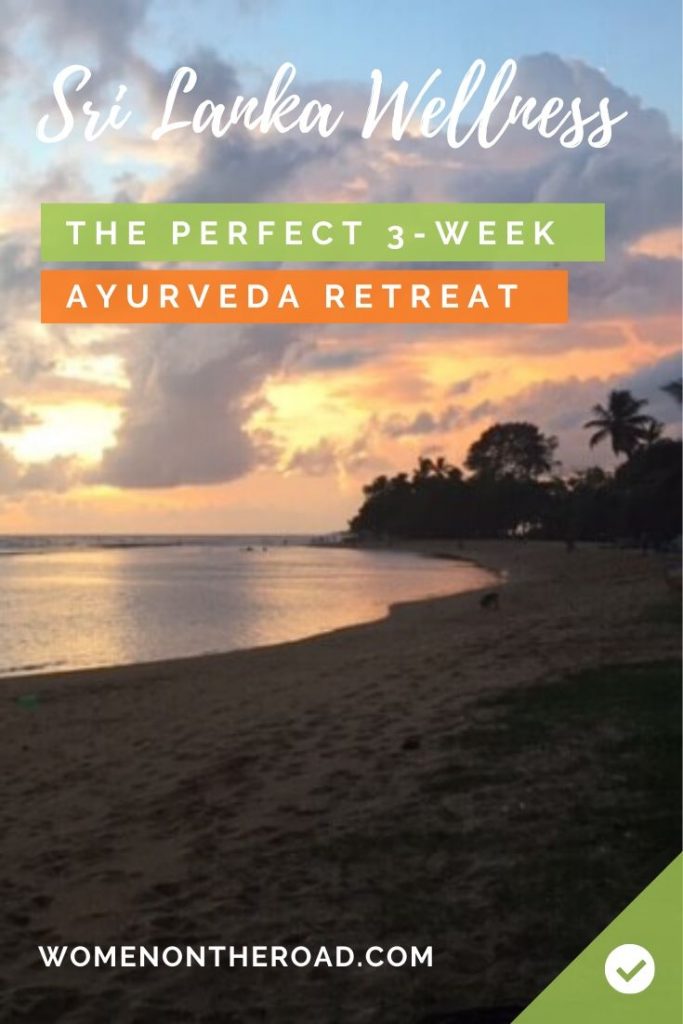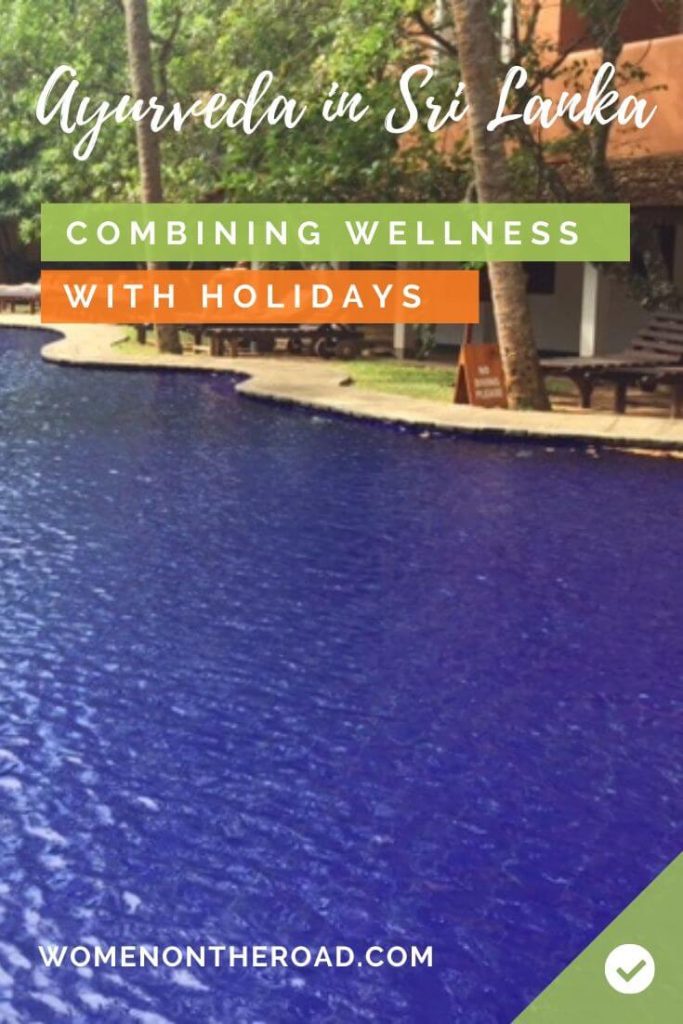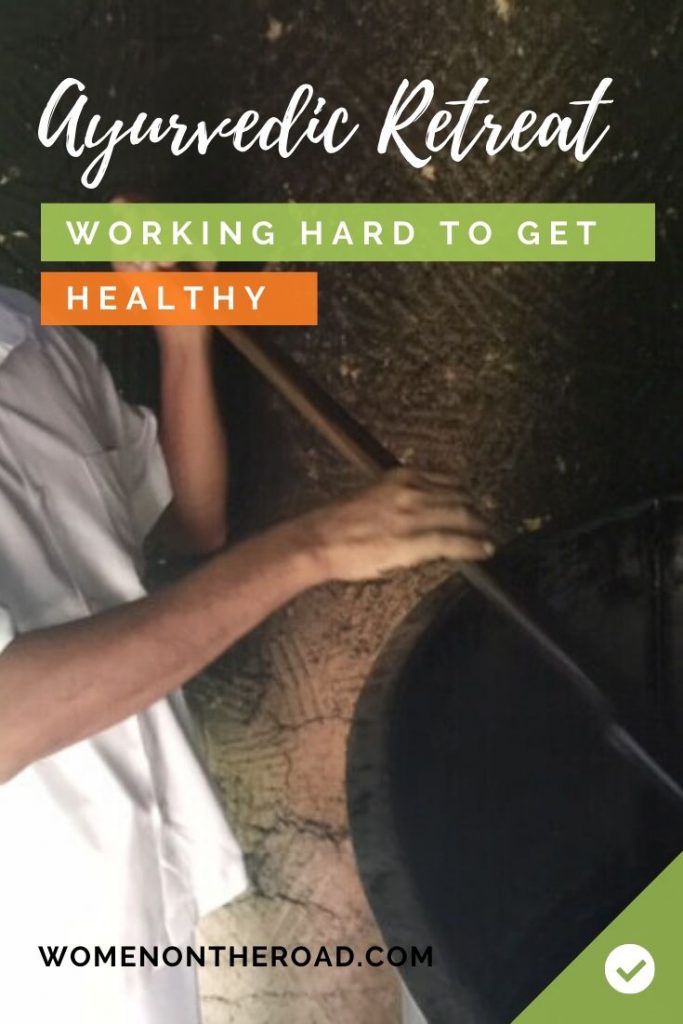Imagine you’re suffering from high blood pressure (I do) or from joints that aren’t as well oiled as they used to be (ditto). Or maybe you’re simply worn out and need a complete break.
When I retired from my job not too long ago I felt I’d been pressed through a needle. I wanted to go somewhere peaceful, be pampered not with luxury but with natural approaches to health, and come home zipping with energy.
So I started my search.
And here’s what I found.
DISCLAIMER: I am a writer, not a doctor, and none of this is medical advice. I have traveled for 50 years to nearly 100 countries and have gained some experience on what works or doesn’t work for me. I share that experience in this series of articles, which can be your starting point for research. But when it comes to actual prevention, treatment and care, ALWAYS consult a qualified medical practitioner.

BUT FIRST – WHY AYURVEDA, AND WHAT IS IT, ANYWAY?
A big part of women’s empowerment is taking charge of our health rather than letting things slide.
Having had a few health worries, I decided to explore things that were foreign to me and push myself beyond my comfort zone.
This turned out to be wildly beyond my comfort zone.
I’d heard about ayurveda, first recorded some 5000 years ago and believed to be the oldest system of health care in the world. I don’t understand it at all but I’m told it is based on creating harmony between body, mind and spirit and, importantly, by preventing illness rather than curing it (although it does a credible job on the cure side too).
It seems to be fashionable: in addition to the predictable crop of people my age, I was surrounded by 20- and 30-year-olds who weren’t ill and just wanted to stay healthy – smart thinking.
Ayurveda uses a holistic approach to health, treating the entire person, not just physical symptoms. It’s about relaxing, eating the right foods, taking natural medication, doing exercise, bodywork (massages and special oil treatments) and spirituality. Trying to put it into words doesn’t do it justice.
Ayurveda tries to treat the underlying cause, not the actual illness.
All I can say is that there is nothing cookie-cutter about authentic ayurveda treatments: each involves specialized remedies based on who you are, your health problems and your dosha – your unique mind-body type.
The modern Western medical profession still stigmatizes alternative treatments like ayurveda. I met two Asian doctors, western-trained, who were here ‘incognito’: they had told their colleagues they were going on vacation, not daring to admit they were undergoing ayurveda treatments. Their very presence of course means medical skepticism isn’t universal, but I know my own doctor is far more comfortable with the world of chemicals than the world of nature.
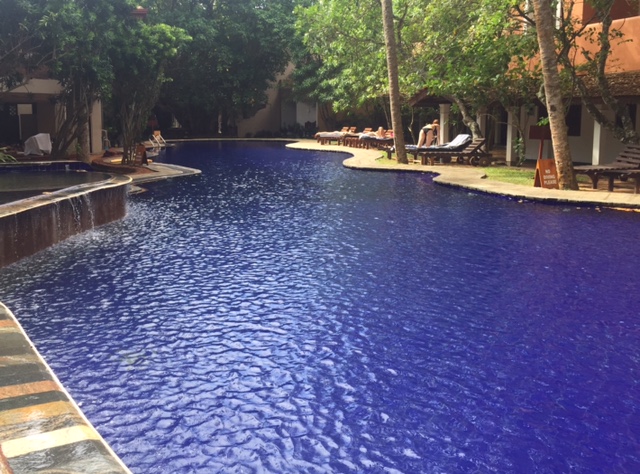
SO HOW DO YOU FIND A GOOD AYURVEDIC CENTER?
Now that you’ve decided to jump in with both feet, you’ll have to decide where to go, just like any other trip.
You can probably find an ayurveda retreat near you. I live in Europe and they were all extraordinarly expensive. I investigated further afield and found two potential locations: Kerala in India, and Sri Lanka.
I opted for Sri Lanka. I’d always wanted to go there, and there were fewer clinics to choose from. The more I looked at India the less I could decide, so I took the easy way out.
While ayurvedic medicine may have originated in India, the Sri Lankan version is every bit as old and effective as its Indian cousin. It just happens to be a combination of both ayurvedic and indigenous medical knowledge.
Here’s what I looked at when trying to decide:
- Cost: flight, room and board, treatment – a flight to India or Sri Lanka cost me less than a flight to the USA (there were several North Americans at my resort but most were German, Swiss and Japanese). Prices are also seasonal – by going off-season I paid 40% less than I would have at a more popular time.
- Nearby attractions: natural beauty, cultural sights… I was warned to do my traveling before any treatment; I spent a week traveling in Sri Lanka and was glad I did or I would have been too exhausted at the end.
- Other opinions: I looked for satisfied customers online by reading trip reviews on a variety of review sites and forums.
- The food: I’m fussy about food and bland dishes with no taste just won’t cut it. If I’m not well fed I’ll end up sneaking out looking for something tasty.
- The type of treatment: This bit of research was mostly useless since I knew so little about ayurveda – I couldn’t understand the differences and had to trust others who had gone before me.
- Woman-friendliness
- and I wanted to do something different.
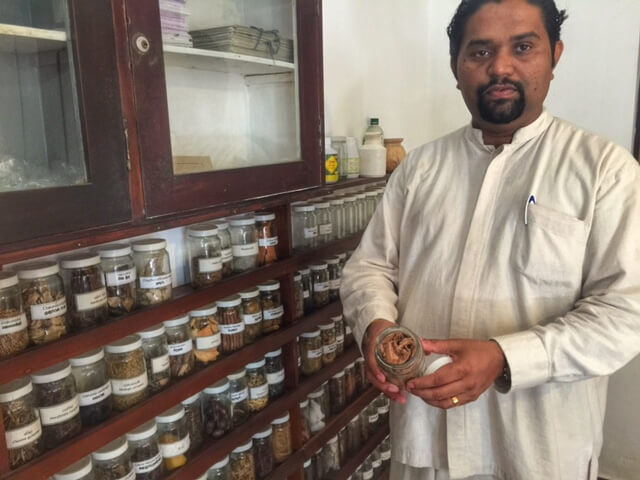
A standard ayurvedic treatment in a good hospital or clinic – at least the Sri Lankan version, as I know nothing of the Indian – should take at least three weeks, four if possible (although I have to admit, after two-and-a-half weeks I felt I was satisfied).
“Other types of medicine focus on the cure,” said Dr Mangala Kumara, one of the Barberyn Resort Clinic’s four consulting doctors. “In ayurveda we look at prevention and how to be as healthy as possible. Ayurveda does some of the work, but you have to do 50% of it yourself.”
It would seem all sorts of ailments respond well to ayurveda but especially skin and respiratory diseases, immune diseases, blood pressure, arthritis and other inflamations, and weight loss, among many others.
I met a woman with multiple sclerosis who threw out her opiate drugs after a couple of days – she was pain-free without them yet had been munching pills every six hours before arriving. (Not that I could recommend not listening to your doctor, but…)
When I got there my blood pressure was shooting through the sky. I left with the blood pressure of a 20-year-old and enough herbal pills – nothing chemical – to see me through a month should I wish to continue taking them (Americans might be hard-pressed to bring them back into the country as they’re herbal).
If you know anything about blood pressure, you’ll be shocked to hear that when I arrived my blood pressure measured 150/100 – and 110/70 when I left, an amazing drop. The low figure stayed with me for months but, as is often the case, one stops being careful and bad habits creep back in…
Whatever the existing medical prejudices, ayurveda works.
In addition to the blood pressure drop, I had a nasal treatment and am breathing through my nose for the first time in years. I no longer have the crushing headaches I was prone to, and I lost just over 5Kg/12lb in three weeks.
Don’t get me wrong though, it’s not a panacea. It didn’t do much for my pinched sciatic nerve, for example, although I think if I’d focused on that rather than on the blood pressure I might well have been on the way to curing my back too.
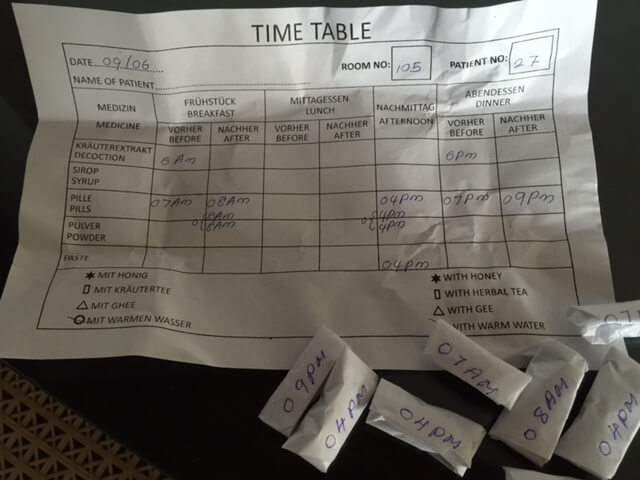
MY AYURVEDIC REGIMEN, DECONSTRUCTED
A three-week ayurvedic treatment is not for the faint-hearted. It’s rather strict, with certain things done at specific hours. While tropical beaches and palms may be involved, an ayurveda cure is hard work.
After years of pizza, steak and ice cream, getting used to mostly vegetarian food lit up every single craving I had. By Day 2 I was ready to pack it in and run home.
Still, I hung in and I’m so glad I did.
The regimen consists of several parts: medicine, body work, and the spiritual element
Each day you check your numbered cubbyhole for your daily meds, which you must swallow at prescribed times throughout the day.
Along with the daily liquids come the daily pills, made of compacted herbs shaped into little round things which look a little like mud balls.
There may also be a paste or powder to dilute in water at a given time. I took about ten medications a day but no confusion is possible: here’s how the pills are delivered. Can’t go wrong with that. Very traditional. And mostly awful tasting.
The medicine is all natural, of course, made on the premises with indigenous plants whose properties have become familiar over centuries. My health center has its own herb garden, from which it prepares concoctions and decoctions in the most traditional way possible.
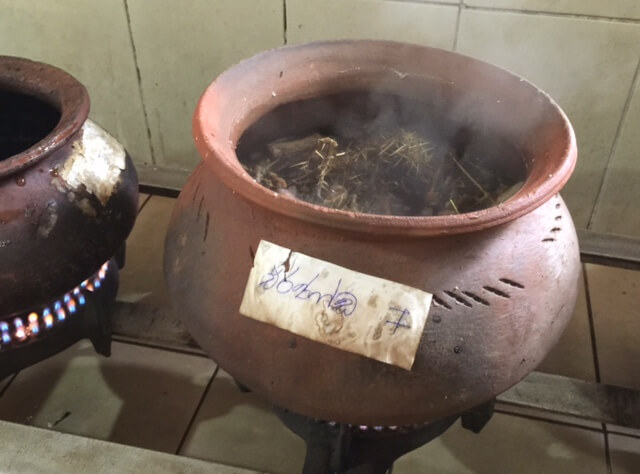
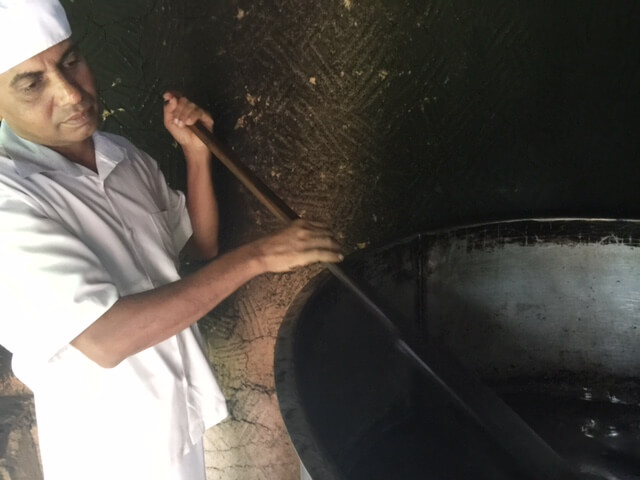
The second – and vastly more entertaining – part of the treatment is the body work.
Initially I thought these were massages to relax the muscles, but the process is actually designed to prepare your skin to absorb large quantities of medicated oils.
There are various of these delightful non-massages throughout the day, punctuated by special treatments targeting your back or neck or legs, depending on your ailment. This is the one time I wanted ailments: the massages were heaven.
You might be assigned herbal steam treatments if you have breathing problems, in addition to mud wraps, herbal baths, internal cleansing, poultices, enemas (only if you need them and accept them – not compulsory!) and acupuncture. Everything you require to get your health back.
The spiritual aspect was more about getting into the right frame of mind.
In my clinic wifi was strongly discouraged, although available in the lobby. We were asked to use it sparingly, since we were there to de-stress and calm down, not work ourselves into a frenzy.
I tried some yoga (unsuccessfully) and tai chi, a vast improvement on the yoga. Meditation classes and lectures rounded off the treatments.
What to pack on your ayurvedic retreat
My friend Melanie is an ayurvedic practitioner – and she also takes a three-week retreat in the Himalayas each year. So I asked her: what specific items would you pack for an ayurveda retreat? Here’s what she suggested:
- Old, comfortable clothes or a sarong – something that doesn’t mind absorbing lots of oil
- Lots of shampoo and soap for washing after the treatments (especially for longer hair)
- Incense can also be very nice, as sometimes you get fed up smelling the same oil day in and day out
- Keeping a journal is worthwhile if you’re interested in writing down your experience and seeing how your moods, thoughts, and body awareness change
- Plenty of books to read (preferably real books rather than ipads or other electronic devices).
- Something to help focus, like a mandala drawing book
Food is a major part of ayurveda.
In my resort hospital (a resort with a hospital licence) the food was Sri Lankan and vegetarian, although some fish was offered at lunch. The food was… GOOD!
Once your treatment is over you receive a list of “allowed” foods for your body type. I won’t stick to it religiously, but given the choice between something good for me and something harmful, I’ll go for the good.
My own journey helped me rediscover my body. I was overweight but not really aware of it. I was who I was and didn’t pay much attention. After three weeks I became physically conscious. I could feel where my body began and ended, and sensations such as satiety were much more powerful.
I also left with greater clarity of purpose, better knowing what my next steps in life were going to be.
As an unexpected bonus I left looking ten years younger, relaxed, smiling, and ready to take on the world.
I also realize I’ll be feeling benefits long after my return. For example, on the second day after I came home I ate poorly – and ended up with a massive stomachache. I’ve been cleansed and detoxed and pummeled and all of a sudden my body is acutely aware when it receives something that isn’t good for it. Next meal I returned to healthy eating and the pain went away.
I went on this retreat with a high dose of skepticism.
I didn’t really believe it would make a difference, but I was willing to give it a try, you know, “just in case”. It won’t cure everything and I’ll still see my GP for most things. But when it comes to serenity and balance, I’m not going to pop a pill to get rid of stress. I’ll try a few tai chi exercises, eliminate harmful foods from my diet, and try to calm down more naturally.
I hope.
AYURVEDIC TREATMENT RESOURCES
Here are a few useful resources to help you learn more:
- Bring Ayurveda into your Life
- What is Ayurvedic Medicine?
- Barberyn Ayurvedic Clinic (this is where I went)
- A good introductory book is Ayurveda, Nature’s Medicine by Drs David Frawley and Subhash Ranade
- The Mandala Coloring Book – I have this and can vouch for its meditative capacities!
— Originally published on 30 June 2015
SHOP THIS POST ON AMAZON
PIN THESE PICTURES AND SAVE FOR LATER!
